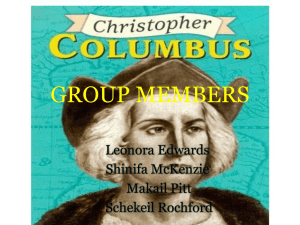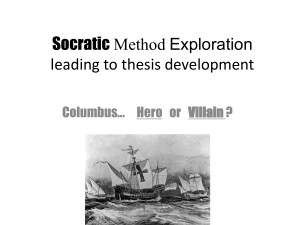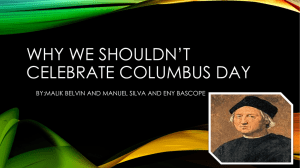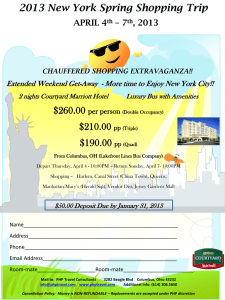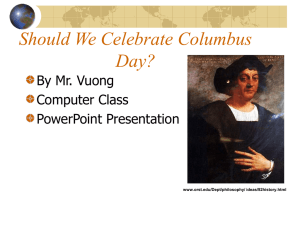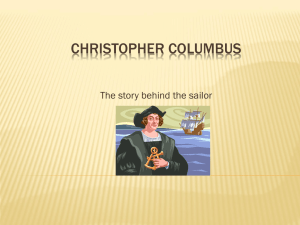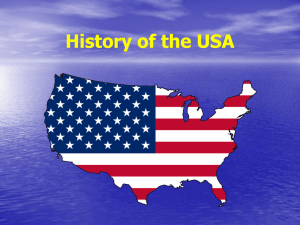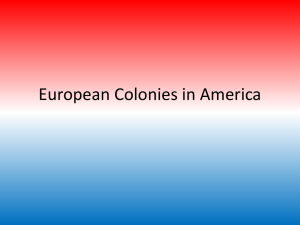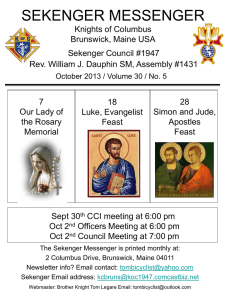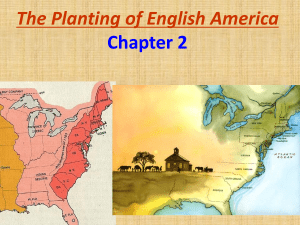The First Explorers
advertisement
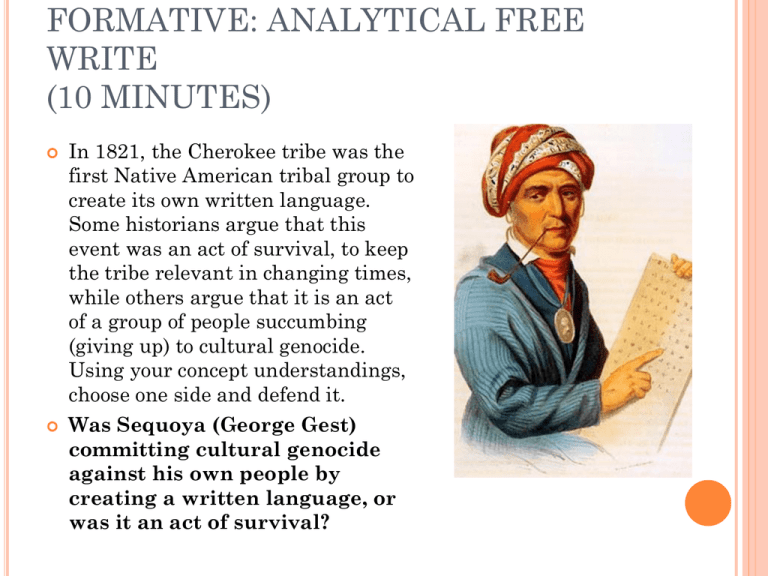
FORMATIVE: ANALYTICAL FREE WRITE (10 MINUTES) In 1821, the Cherokee tribe was the first Native American tribal group to create its own written language. Some historians argue that this event was an act of survival, to keep the tribe relevant in changing times, while others argue that it is an act of a group of people succumbing (giving up) to cultural genocide. Using your concept understandings, choose one side and defend it. Was Sequoya (George Gest) committing cultural genocide against his own people by creating a written language, or was it an act of survival? THE FIRST EXPLORERS Unit 2 – Part 2: Explorers and Colonization Literature Christopher Columbus’ Epistola & John Smith’s The General History of Virginia LEARNING TARGETS Students will be able to discuss the historical background and contemporary contexts of Exploratory & Colonialism Literature and relate them to today’s American culture. EXPLORERS!!! Hey Everybody! Let’s go to strange new lands and meet strange new people! And then let’s enslave them so they can later die from diarrhea! HUMAN MIGRATION MAP And with all this human migration across the planet, we colonized this world with our poop before anything else! THE FIRST WRITTEN RECORD OF THE NEW WORLD The first written account of Europeans in the New World is titled THE VINLAND SAGA THE VINLAND SAGA – THE FIRST EUROPEAN SIGHTING OF THE NEW WORLD. According to this text, an explorer by the name of Bjarni Herjolfsson chanced upon a long strip of land while sailing west out of Norway in 986 – he marked it on his map and sailed the coast for a few days. According to the text, Bjarni marked, “this country seems to be worthless” (Horwitz 12). THE VINLAND SAGA Leif Eiriksson, a Norse explorer, who landed on Nova Scotia, Canada - 400 years before Columbus. Eiriksson bought Herjolfsson’s boat and sailed to the New World. WHERE WAS LEIF? Eriksson (24 at the time) captained his crew to what is now Newfoundland, Canada. He found grapes and named the area “The Land of Wine” – Vinland. He loaded his boat with timber and grapes and left. He never returned. Christopher Columbus Columbus set sail for the New World in 1492. Wrote an EPISTOLARY journal creatively called Epistola. “EPISTOLARY” A series of personal letters published in book-form as a written account or story. What Were You Taught In School About Columbus? COLUMBUS MYTH Columbus did not set out to prove that the world was round; this was pretty much common knowledge during the 15th-Century. Instead, he was looking for a western passage to Asia. A TRUTH Columbus did not “discover” America. He never set foot on the United States. Rather, he landed in the Caribbean on the island he named San Salvador, today it is the area called The Bahamas. * This is not a historical reality and should be immediately forgotten Columbus Realities He knew that he wasn’t Columbus was a fervent in India when he ate Christian believedget the food!– he Europeans that God haddiarrhea chosen when him explosive for athey great eatdestiny. Indian food!* When he was 14, Columbus got his first job: Pirate. It’s a myth that Columbus thought he landed in India – but rather, he believed he found a series of islands in the Indian Ocean. (SOURCE: Zinn, Howard. The People’s History of the World) MORE Columbus and future explorers are blamed for spreading disease to natives. However, Columbus’ own men caught diseases from the natives – the majority of them dying as a result. Some of Columbus’ ancient ancestors were Vikings – people who plundered and conquered distant lands for personal profit… makes you think! Columbus’ Mistakes Thinking that he was in the India region, the indigenous people were called Indians. They named that area The West Indies. Columbus died thinking he was in Indian Ocean – he never knew he discovered a “New World” (Usarchives.gov). ARAWAKS The first indigenous people Columbus contacted were the ARAWAKS. They promised Columbus gold and a water passage that ran through the land. To protect his “investment,” Columbus filled his letters with tales of sea monsters and violent, inhuman, cannibalistic indigenous peoples – many of these observations written by Columbus continue today as stereotypes of Native American culture (Horwitz 64). Horwitz, Tony. A Voyage Long and Strange: Rediscovering the New World. Henry Holt Publishers: New York, NY. WHAT COLUMBUS DID… Columbus enslaved these people and sent many back to Europe as gifts to Kings and Queens (Loewen 52). Today, Arawaks are near extinct; most died from smallpox (Loewen 54). Loewen, James. Lies My Teacher Told Me: Everything Your American History Book Got Wrong. Touchstone Publishers: New York, NY. And isn’t diarrhea a symptom of smallpox!?!?! Ah… crap! COLUMBUS IMPACT ON FUTURE COLONIALISM Epistola made Columbus famous. This fame financed three more trips for a total of four journeys to the West Indies. The published text was distributed around Europe and became the primary source document to stereotyping nonEuropeans. ETHNOCENTRISM Historians and literary scholars declare that Epistola, The General History of Virginia, and other colonial texts are stained with the writers’ ETHNOCENTRISM. ETHNOCENTRISM: When a person unknowingly or knowingly places their own culture and beliefs as a societal norm, and rejects all cultural beliefs of different ethnic groups or cultures. THE TRIAL OF CHRISTOPHER COLUMBUS Columbus was the active Governor (President) of the West Indies until 1500 when he was arrested for cruelty to slaves. Twenty-Three witnesses at his trial claimed to see Columbus torture the natives. He was sent back to Europe where he died without property or governing power. COLUMBUS DISCUSSION Despite all of this evidence to the contrary, American elementary schools teach Columbus as if he is a national hero. Why does American culture portray Columbus in this manner? END OF PART ONE - HOMEWORK Read the excerpt from Columbus’s Epistola. Find textual evidence that supports both iconic images of Columbus: the hero and the villain. Highlight quotes from his letter (use different colors) that supports both viewpoints. How about a bathroom break! I know I have the Green Apple Splatters! COLONIAL LITERATURE: WRITINGS OF THE EXPLORERS – PART II Jamestown and Roanoke John Smith’s The General History of Virginia I love this era of American literature! Lots of death, disease, and diarrhea! I can’t wait! American Colonization: ROANOAKE COLONY: First American Colony set in 1585. Ninety men, seventeen women, and eleven children were left behind to run the colony when their ships returned to England for supplies. THE LOST COLONY OF ROANOKE When the colonial ships returned to Roanoke, they discovered that everybody had disappeared. There was no blood or trace of remains except three corpses that were recently given a Christian burial. Surviving colonists were never found. Holy Crap, Mr. P! That is some seriously messed up doo doo! The first Europeans in America sdf just vanished!!! Well, where the heck did they go!?!? Did they all die from diarrhea? NICE!! ! WHAT HAPPENED TO ROANOKE? Theory 1: Massacred by the natives Theory 2: Turned cannibal and later starved to death Theory 3: Moved north to the island of Croaton and lived with a local tribe. Theory 4: EVIDENCE EVIDENCE OF THEORY 3: If the original colonists were under attack from the local natives, they were supposed to carve a crucifix into the fort wall. This was not found. The word “CROATOAN” was carved into the fort, also “CRO” carved into a tree with an incomplete A. It was believed that this meant that colonists had moved to a nearby island to live with the local natives. Generations later, blueeyed natives would be born from the local tribes. FIRST SUCCESSFUL COLONY JAMESTOWN COLONY: Founded in 1607 – Second American Colony. Named for King James I SOUND FAMILIAR? Three hardships faced by Jamestown: lack of food, harsh weather, and disease. WHAT DO YOU KNOW ABOUT JOHN SMITH? “AN AMBITIOUS, UNWORTHY, AND VAIN-GLORIOUS FELLOW.” Told elaborate stories of his war against the Turkish Army – claiming to be trained in secrets of war, claimed he beheaded three Turkish commanders. Sentenced to death by Capt. Christopher Newport while on the voyage to the New World. Charged with drunkenness, theft, lying, and “behavior unfit for the sea” (starting fights). D’OH! Upon arrival in the New World, secret sealed orders of the voyage’s financier, The Virginia Company, were broken open. The orders named John Smith to be leader of the Jamestown Colony. JOHN SMITH: President of Jamestown in 1608 and 1609. Wrote THE GENERAL HISTORY OF VIRGINIA. Used HYPERBOLE to describe his encounters with indigenous cultures. WHAT IS HYPERBOLE? HYPERBOLE – Extreme exaggeration in a story in order to emphasize a point. A GENERALL HISTORIE OF VIRGINIA, NEWENGLANDE, AND THE SUMMER ISLES THE GENERAL HISTORY OF VIRGINIA: Is a HISTORY (literary term: A telling of historical events and usually written with a purpose of persuasion. Smith’s writings are SUBJECTIVE – A person’s own personal account and may not be entirely factual. Ideas and beliefs getting in the way of accurately depicting events Smith paints himself as an invincible hero who is singlehandedly responsible for the success of Jamestown. Why He Wrote It: In 1624, almost 20 years after Jamestown, The Virginia Company announced it was publishing a HISTORY of the Jamestown colony – John Smith found out that he would not be mentioned within the book. John Smith beat The Virginia Company to publication, printing The General History of Virginia before their story could be published. Written nearly 20 years after the fact, The General History of Virginia does not mention The Virginia Company. HISTORIANS HAVE NOT BEEN KIND TO JOHN SMITH Today, the writings of The Virginia Company have disappeared through time. John Smith’s depiction of Jamestown in The General History of Virginia is the only resource we have about our first successful colony in America. Historians and literary ETHNOCENTRISM scholars declare that The General History of Virginia is stained with Smith’s own ETHNOCENTRISM. ETHNOCENTRISM: When a person unknowingly or knowingly places their own culture and beliefs as a societal norm, and rejects all cultural beliefs of different ethnic groups or cultures. BIRTH OF THE “AMERICAN DREAM.” "Here every man may be master and owner of his owne labour and land...If he have nothing but his hands, he may...by industrie quickly grow rich.” From “A General History of Virginia” Hooray! The American Dream brought more Europeans! More Europeans means more diarrhea!!! Let’s go find you a toilet, my friend! Sweet! REVIEW OF TERMS AND CONCEPTS Indigenous – “History” (literary term) – Subjectivity – Objectivity – Hyperbole – Ethnocentrism –
